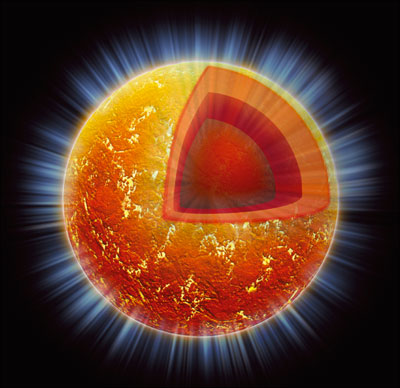
This illustration shows a cut-out of the interior of the neutron star. Densities increase from the orange crust to the red core and the inner red ball, where the superfluid resides.
Image credit: NASA/CXC/M Weiss.
The rapid decline in temperature of a young neutron star in the supernova remnant Cassiopeia A (Cas A) suggests superfluidity and superconductivity at its core. This conclusion, based on observations by NASA’s Chandra X-ray Observatory, gives new insights into nuclear interactions at ultra-high densities.
Cas A was the “first light” target of the Chandra satellite. Only a month after launch, the image released on 26 August 1999 revealed the filamentary structure of the supernova remnant with details that competed with the best optical images – an incredible achievement for X-ray instrumentation. A tiny spot at the heart of the nebula was identified as a neutron star (CERN Courier October 2004 p19). It has previously remained unnoticed because no pulsations were detected from Cas A, unlike from the pulsar in the Crab Nebula, which is a neutron star spinning 30 times a second (CERN Courier January/February 2006 p10, CERN CourierNovember 2008 p11). Another oddity of Cas A is that nobody noticed the onset of the supernova some 330 years ago, except maybe John Flamsteed, who reports the observation of a sixth magnitude star in August 1680 near the position of the remnant. The explosion of the massive star only 11,000 light-years away should have been visible from Europe, unless it was heavily obscured by dust (CERN Courier January/February 2006 p10).
Recent observations of Cas A by Chandra have now revealed another surprise about its neutron star: that its surface has cooled by about 4% in 10–years. According to two independent studies, this dramatic drop in temperature is evidence for superfluid and superconducting matter in the interior of the ultra-dense star. Dany Page from the National Autonomous University of Mexico and colleagues submitted their results to Physical Review Letters just two days before the submission of another letter to the Monthly Notices of the Royal Astronomical Society by Peter Shternin of the Ioffe Institute in St Petersburg and collaborators.
While superfluidity is observed only at temperatures near absolute zero on Earth, theorists have estimated that this friction-free state of matter may survive temperatures of hundreds of million degrees in the ultra-dense core of neutron stars. The nuclear density of neutron stars – one teaspoon of their material has a mass of the order of a 1000–million tonnes – forces protons and electrons to merge, resulting in a star composed mostly of neutrons. The new results suggest strongly that the remaining protons in the star’s core are in a superfluid state and – because they carry a charge – also form a superconductor.
Both teams further show that the rapid cooling in Cas–A can be explained by the formation of a neutron superfluid in the stellar core within about the past 100–years, as seen from Earth. This should continue for a few decades before slowing down. The cool-down is caused by the production of superfluid neutron pairs – so-called Cooper pairs – accompanied by the emission of two neutrinos per pair, which escape from the star and carry away energy.
With Cas A, astronomers have been lucky to catch a young neutron star just in the transition to superfluid state. It allows them to set the critical temperature for the onset of superfluidity for neutrons interacting via the strong force to about 500 million degrees. The results are also important for understanding properties of neutron stars, such as magnetar outbursts and “glitches”. The latter are the sudden spin-up of pulsars, probably as a result of quakes in the crust of the neutron stars. There has been previous evidence for superfluidity, but at subnuclear densities in the crust. The research into Cas A provides the first direct evidence for superfluid neutrons and protons in the core of the star.





